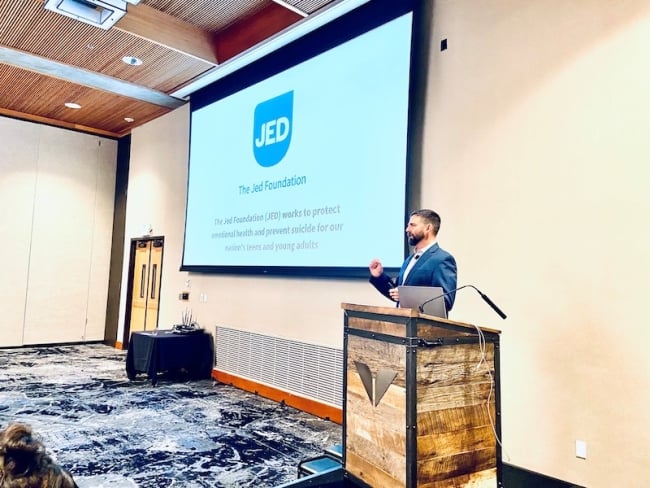You have /5 articles left.
Sign up for a free account or log in.

Kurt Michael, pictured here, works with colleges to develop their postvention strategies.
The Jed Foundation
What happens when a death by suicide occurs at a small, rural college campus that lacks the mental health infrastructure to support all the students gripped by grief, guilt or fear?
In the past, those students might have been forced to navigate the aftermath all alone or draw on the surrounding community—which might be constrained by its own mental health shortages. Now, however, the college can call The Jed Foundation (JED).
The antisuicide nonprofit has begun offering “postvention” consulting services to campuses that have experienced a student death by suicide. Suicide is the second leading cause of death, after accidents, among youth between 12 and 24, and over the years, JED found itself fielding more and more calls from college officials who told a similar tale: a student had died by suicide on their campus, and they didn’t have any protocol for dealing with the aftermath.
“I can’t give you an exact percentage, but let’s just throw a number out there—let’s say half of the schools that we’re interacting with don’t have anything on the books,” said Kurt Michael, the senior clinical director at JED, who often works on the ground with colleges and universities after a tragedy.
“I can tell you that the anxiety I sit next to when I’m sitting next to administrators is palpable: you can feel it. To have [a JED consultant] sit next to them, whether virtually or in person, is quite a relief,” he said. “It feels, I think, very [reassuring] … that there’s somebody who’s kind of been down this road.”
JED consultants advise administrators on important decisions related to postvention, such as whether or not to hold a memorial service (best practices recommend that if one is held, it be conducted in the same way it would be for a death that wasn’t by suicide). They can also help lead listening sessions for frustrated students or even help them process their grief if the campus or community lacks the necessary mental health resources.
“For us to be effective for them, we first need to understand what’s available to these communities,” Michael said. “Every campus, every school community, is different, and we want to make sure that we’re customizing either that plan or that response process.”
The Origins of Postvention
The term “postvention” emerged in the 2010s to describe the policies, processes and guidelines that universities (as well as K-12 schools and other institutions) should follow in the wake of a student suicide. They aim to support those who are grieving the deceased and lower the community’s anxiety while also reducing the risk of suicide contagion, which can occur when such a death occurs within a tight-knit community like a college. Postvention practices also strive to avoid “institutionalizing grief,” or making the suicide such an intrinsic part of the campus character or history that community members no longer feel safe.
JED is part of the Higher Education Mental Health Alliance, a partnership of several organizations focused on improving mental health on college campuses, which released a resource in 2014 that universities could use to guide their own postvention planning, based on the idea that it is best to have protocols and plans in place well before a death by suicide occurs. (JED also offers consulting services for universities and schools that are proactively developing postvention plans.)
The resource recommends establishing a postvention committee, made up of representatives from campus offices ranging from student affairs to risk management, and provides advice for developing protocols that will best meet each university’s individual needs.
Victor Schwartz, former chief medical officer of JED who now serves as senior associate dean for wellness and student life at the City University of New York School of Medicine, led the creation of HEMHA’s resource. He said that the organization wanted to publish postvention guidance in large part because many of its members had worked on campuses where a student had died by suicide and hoped to share what they had learned from those experiences.
“Those of us who had worked for a long time in college mental health—and I’ve been in this area since 1990—simply had to deal with these events, unfortunately, from time to time,” he said. “We realized intuitively and in speaking with each other that there were things that could be done that would make a difference.”
One of the greatest challenges in developing postvention protocols, however, has been the lack of available research on the subject. Although suicide is a leading cause of death for young people, it is rare enough on college campuses that study its aftermaths empirically can be difficult. Schwartz said the HEMHA guide was based on participants’ personal and professional experiences and existing literature from both the broader suicide-prevention community and college mental health experts.
Now, almost a decade after the guidance was first released, some universities have developed their own postvention protocols. Others are still left floundering when a student dies by suicide.
Jodi Frey, a professor at the University of Maryland School of Social Work and an expert on workplace postvention, said universities have many reasons for failing to develop a postvention plan. Administrators may be operating under the debunked theory that talking about suicide can encourage it, or they might think they don’t have enough expertise to handle the planning appropriately.
Universities may also be in a tight financial spot and unable to spend resources on planning for a student death by suicide that officials fervently hope will never come. But there is overlap between postvention preparation and readiness for other types of emergencies, she said—including drafting different communications for different constituents.
“Encouraging folks to invest in this for suicide as well as other incidents that they’re going to experience can help to decrease the barrier,” she said.
Those universities that do have postvention practices in place have found them valuable. North Carolina State University has had postvention protocols in place since 2015, which was helpful when 14 students died—including seven by suicide—during the last academic year.
“The efforts aim to provide support to those impacted by a crisis and to help the community return to normal routine to the greatest extent possible as soon as is feasible,” Mick Kulikowski, director of strategic communications and media relations at North Carolina State, wrote in an email to Inside Higher Ed. “That includes stabilizing the environment; reducing the risk of negative behaviors; supporting the grieving or adjustment process; limiting the risk of further suicides through contagion; communicating with those needing to know, including the campus community if necessary; and providing administrative oversight and logistics support.”




